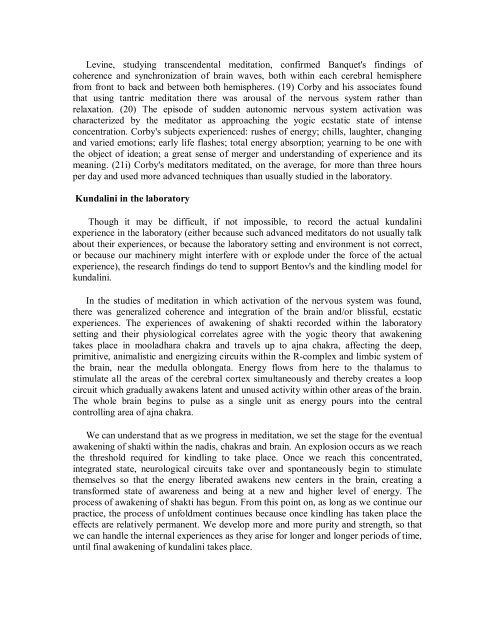Kundalini.Tantra.by.Satyananda.Saraswati
You also want an ePaper? Increase the reach of your titles
YUMPU automatically turns print PDFs into web optimized ePapers that Google loves.
Levine, studying transcendental meditation, confirmed Banquet's findings of<br />
coherence and synchronization of brain waves, both within each cerebral hemisphere<br />
from front to back and between both hemispheres. (19) Cor<strong>by</strong> and his associates found<br />
that using tantric meditation there was arousal of the nervous system rather than<br />
relaxation. (20) The episode of sudden autonomic nervous system activation was<br />
characterized <strong>by</strong> the meditator as approaching the yogic ecstatic state of intense<br />
concentration. Cor<strong>by</strong>'s subjects experienced: rushes of energy; chills, laughter, changing<br />
and varied emotions; early life flashes; total energy absorption; yearning to be one with<br />
the object of ideation; a great sense of merger and understanding of experience and its<br />
meaning. (21i) Cor<strong>by</strong>'s meditators meditated, on the average, for more than three hours<br />
per day and used more advanced techniques than usually studied in the laboratory.<br />
<strong>Kundalini</strong> in the laboratory<br />
Though it may be difficult, if not impossible, to record the actual kundalini<br />
experience in the laboratory (either because such advanced meditators do not usually talk<br />
about their experiences, or because the laboratory setting and environment is not correct,<br />
or because our machinery might interfere with or explode under the force of the actual<br />
experience), the research findings do tend to support Bentov's and the kindling model for<br />
kundalini.<br />
In the studies of meditation in which activation of the nervous system was found,<br />
there was generalized coherence and integration of the brain and/or blissful, ecstatic<br />
experiences. The experiences of awakening of shakti recorded within the laboratory<br />
setting and their physiological correlates agree with the yogic theory that awakening<br />
takes place in mooladhara chakra and travels up to ajna chakra, affecting the deep,<br />
primitive, animalistic and energizing circuits within the R-complex and limbic system of<br />
the brain, near the medulla oblongata. Energy flows from here to the thalamus to<br />
stimulate all the areas of the cerebral cortex simultaneously and there<strong>by</strong> creates a loop<br />
circuit which gradually awakens latent and unused activity within other areas of the brain.<br />
The whole brain begins to pulse as a single unit as energy pours into the central<br />
controlling area of ajna chakra.<br />
We can understand that as we progress in meditation, we set the stage for the eventual<br />
awakening of shakti within the nadis, chakras and brain. An explosion occurs as we reach<br />
the threshold required for kindling to take place. Once we reach this concentrated,<br />
integrated state, neurological circuits take over and spontaneously begin to stimulate<br />
themselves so that the energy liberated awakens new centers in the brain, creating a<br />
transformed state of awareness and being at a new and higher level of energy. The<br />
process of awakening of shakti has begun. From this point on, as long as we continue our<br />
practice, the process of unfoldment continues because once kindling has taken place the<br />
effects are relatively permanent. We develop more and more purity and strength, so that<br />
we can handle the internal experiences as they arise for longer and longer periods of time,<br />
until final awakening of kundalini takes place.














![[Lonely Planet] Sri Lanka](https://img.yumpu.com/59845622/1/169x260/lonely-planet-sri-lanka.jpg?quality=85)


